Disability Management and Return to Work Assignment
VerifiedAdded on 2023/04/22
|12
|3590
|231
AI Summary
This document discusses disability management and return to work assignment. It covers topics such as safety measures, practices related to security incidents, and the role of stakeholders in the return to work process.
Contribute Materials
Your contribution can guide someone’s learning journey. Share your
documents today.

RETURN TO WORK 1
DIABILITY MANAGENT AND RETURN TO WORK ASSIGNMENT
First Name Last Name
HRES2303: Return to Work Assignment
Instructor’s Name
Date of Submission
DIABILITY MANAGENT AND RETURN TO WORK ASSIGNMENT
First Name Last Name
HRES2303: Return to Work Assignment
Instructor’s Name
Date of Submission
Secure Best Marks with AI Grader
Need help grading? Try our AI Grader for instant feedback on your assignments.
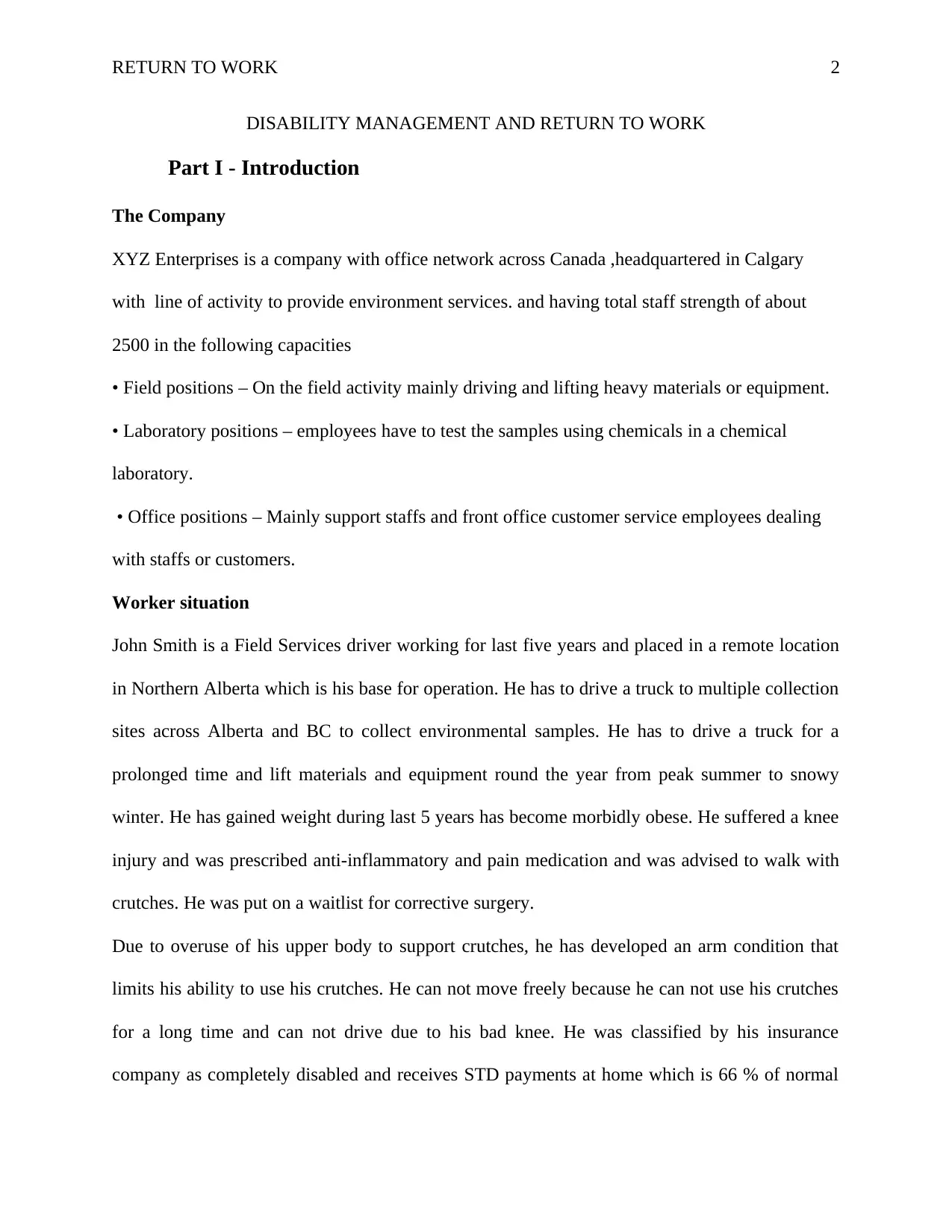
RETURN TO WORK 2
DISABILITY MANAGEMENT AND RETURN TO WORK
Part I - Introduction
The Company
XYZ Enterprises is a company with office network across Canada ,headquartered in Calgary
with line of activity to provide environment services. and having total staff strength of about
2500 in the following capacities
• Field positions – On the field activity mainly driving and lifting heavy materials or equipment.
• Laboratory positions – employees have to test the samples using chemicals in a chemical
laboratory.
• Office positions – Mainly support staffs and front office customer service employees dealing
with staffs or customers.
Worker situation
John Smith is a Field Services driver working for last five years and placed in a remote location
in Northern Alberta which is his base for operation. He has to drive a truck to multiple collection
sites across Alberta and BC to collect environmental samples. He has to drive a truck for a
prolonged time and lift materials and equipment round the year from peak summer to snowy
winter. He has gained weight during last 5 years has become morbidly obese. He suffered a knee
injury and was prescribed anti-inflammatory and pain medication and was advised to walk with
crutches. He was put on a waitlist for corrective surgery.
Due to overuse of his upper body to support crutches, he has developed an arm condition that
limits his ability to use his crutches. He can not move freely because he can not use his crutches
for a long time and can not drive due to his bad knee. He was classified by his insurance
company as completely disabled and receives STD payments at home which is 66 % of normal
DISABILITY MANAGEMENT AND RETURN TO WORK
Part I - Introduction
The Company
XYZ Enterprises is a company with office network across Canada ,headquartered in Calgary
with line of activity to provide environment services. and having total staff strength of about
2500 in the following capacities
• Field positions – On the field activity mainly driving and lifting heavy materials or equipment.
• Laboratory positions – employees have to test the samples using chemicals in a chemical
laboratory.
• Office positions – Mainly support staffs and front office customer service employees dealing
with staffs or customers.
Worker situation
John Smith is a Field Services driver working for last five years and placed in a remote location
in Northern Alberta which is his base for operation. He has to drive a truck to multiple collection
sites across Alberta and BC to collect environmental samples. He has to drive a truck for a
prolonged time and lift materials and equipment round the year from peak summer to snowy
winter. He has gained weight during last 5 years has become morbidly obese. He suffered a knee
injury and was prescribed anti-inflammatory and pain medication and was advised to walk with
crutches. He was put on a waitlist for corrective surgery.
Due to overuse of his upper body to support crutches, he has developed an arm condition that
limits his ability to use his crutches. He can not move freely because he can not use his crutches
for a long time and can not drive due to his bad knee. He was classified by his insurance
company as completely disabled and receives STD payments at home which is 66 % of normal

RETURN TO WORK 3
wage. He is unable to manage with this amount. He wants to return to full-time work so that he
can earn his regular income. Since he can not fulfill his regular field duties, he has to fulfill
changed tasks and has to submit a graduated schedule with a few hours per day for the start,
which gradually increases to full time (Hou., Liang., Sheu., Hsieh. & Chuang, 2013).
Safety measures
• The company has security policies and work instructions that cover all security-related
procedures within the company.
• Employees must attend security tailgate meetings once a week. These meetings share useful
information including employees exchanging information of different scenarios from practical
cases.
• Supervisors use security tailgate meetings to send various messages to employees,
• Safety audits are performed once a year by the occupational safety department.
Practices related to security incidents
• All security incidents are taken very seriously. Injured employees are taken to a medical facility
as soon as possible after an incident. The relevant documents are filled in and the incident is
reported to the WCB of the province if necessary.
• However for allocation of modified duty or full duty during return to work, there is no standard
procedure and employees get very less support from all the stakeholders from the management
side. ( Saunders & Nedelec, 2014).
wage. He is unable to manage with this amount. He wants to return to full-time work so that he
can earn his regular income. Since he can not fulfill his regular field duties, he has to fulfill
changed tasks and has to submit a graduated schedule with a few hours per day for the start,
which gradually increases to full time (Hou., Liang., Sheu., Hsieh. & Chuang, 2013).
Safety measures
• The company has security policies and work instructions that cover all security-related
procedures within the company.
• Employees must attend security tailgate meetings once a week. These meetings share useful
information including employees exchanging information of different scenarios from practical
cases.
• Supervisors use security tailgate meetings to send various messages to employees,
• Safety audits are performed once a year by the occupational safety department.
Practices related to security incidents
• All security incidents are taken very seriously. Injured employees are taken to a medical facility
as soon as possible after an incident. The relevant documents are filled in and the incident is
reported to the WCB of the province if necessary.
• However for allocation of modified duty or full duty during return to work, there is no standard
procedure and employees get very less support from all the stakeholders from the management
side. ( Saunders & Nedelec, 2014).
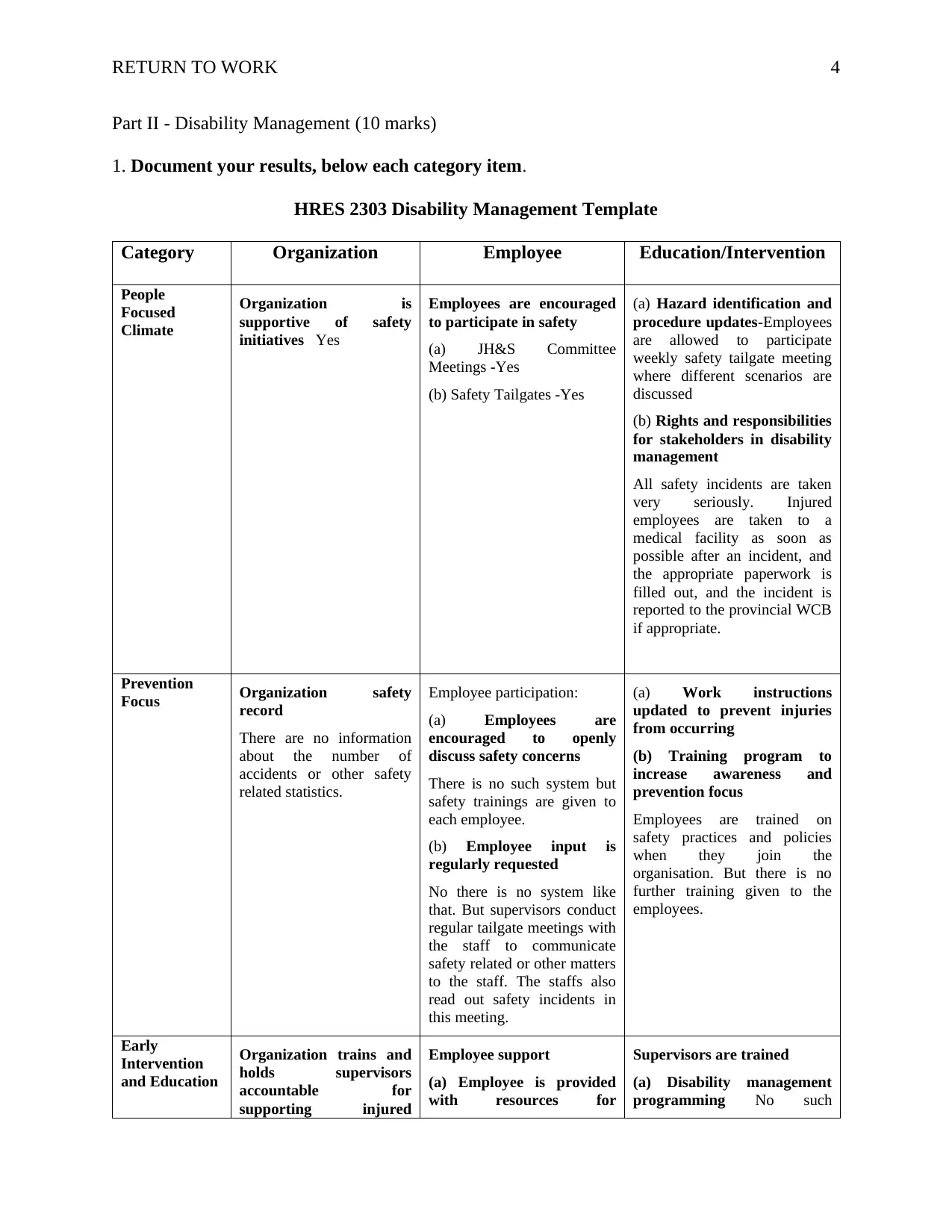
RETURN TO WORK 4
Part II - Disability Management (10 marks)
1. Document your results, below each category item.
HRES 2303 Disability Management Template
Category Organization Employee Education/Intervention
People
Focused
Climate
Organization is
supportive of safety
initiatives Yes
Employees are encouraged
to participate in safety
(a) JH&S Committee
Meetings -Yes
(b) Safety Tailgates -Yes
(a) Hazard identification and
procedure updates-Employees
are allowed to participate
weekly safety tailgate meeting
where different scenarios are
discussed
(b) Rights and responsibilities
for stakeholders in disability
management
All safety incidents are taken
very seriously. Injured
employees are taken to a
medical facility as soon as
possible after an incident, and
the appropriate paperwork is
filled out, and the incident is
reported to the provincial WCB
if appropriate.
Prevention
Focus Organization safety
record
There are no information
about the number of
accidents or other safety
related statistics.
Employee participation:
(a) Employees are
encouraged to openly
discuss safety concerns
There is no such system but
safety trainings are given to
each employee.
(b) Employee input is
regularly requested
No there is no system like
that. But supervisors conduct
regular tailgate meetings with
the staff to communicate
safety related or other matters
to the staff. The staffs also
read out safety incidents in
this meeting.
(a) Work instructions
updated to prevent injuries
from occurring
(b) Training program to
increase awareness and
prevention focus
Employees are trained on
safety practices and policies
when they join the
organisation. But there is no
further training given to the
employees.
Early
Intervention
and Education
Organization trains and
holds supervisors
accountable for
supporting injured
Employee support
(a) Employee is provided
with resources for
Supervisors are trained
(a) Disability management
programming No such
Part II - Disability Management (10 marks)
1. Document your results, below each category item.
HRES 2303 Disability Management Template
Category Organization Employee Education/Intervention
People
Focused
Climate
Organization is
supportive of safety
initiatives Yes
Employees are encouraged
to participate in safety
(a) JH&S Committee
Meetings -Yes
(b) Safety Tailgates -Yes
(a) Hazard identification and
procedure updates-Employees
are allowed to participate
weekly safety tailgate meeting
where different scenarios are
discussed
(b) Rights and responsibilities
for stakeholders in disability
management
All safety incidents are taken
very seriously. Injured
employees are taken to a
medical facility as soon as
possible after an incident, and
the appropriate paperwork is
filled out, and the incident is
reported to the provincial WCB
if appropriate.
Prevention
Focus Organization safety
record
There are no information
about the number of
accidents or other safety
related statistics.
Employee participation:
(a) Employees are
encouraged to openly
discuss safety concerns
There is no such system but
safety trainings are given to
each employee.
(b) Employee input is
regularly requested
No there is no system like
that. But supervisors conduct
regular tailgate meetings with
the staff to communicate
safety related or other matters
to the staff. The staffs also
read out safety incidents in
this meeting.
(a) Work instructions
updated to prevent injuries
from occurring
(b) Training program to
increase awareness and
prevention focus
Employees are trained on
safety practices and policies
when they join the
organisation. But there is no
further training given to the
employees.
Early
Intervention
and Education
Organization trains and
holds supervisors
accountable for
supporting injured
Employee support
(a) Employee is provided
with resources for
Supervisors are trained
(a) Disability management
programming No such
Secure Best Marks with AI Grader
Need help grading? Try our AI Grader for instant feedback on your assignments.

RETURN TO WORK 5
employee- There is no
such policy like this.
(a) Call placed to injured
worker within 1-2 weeks
post injury
There is no such policy in
the organization but all
safety incidents are taken
very seriously. Injured
employees are taken to a
medical unit immediately
after any accident and
necessary paperwork is
done and the incident is
reported to provincial
WCB if required.
(b) Communication of
support for resource
provision and RTW
process
When an employee is unfit
to join duty he gets 66 % of
pay. There is no such
system in the company and
the company is slow in
implementing this even if
employees voluntarily
request to return to work.
psychological and physical
66% pay is permitted during
absence.
(b) Employee is provided
with a return to work
package explaining the
process in detail. There is
no such system. The
company is slow in
implementing this policy The
employees have to wait for a
long period to return to either
modified or full work.
training is given. But when an
incident takes place he is
promptly given medical
assistance and necessary paper
works are done.
(b) Factors supporting RTW
An incident is reported to
RTW.
(c)Effective communication
techniques including active
listening and supportive
language There is no such
culture in the company. It can
be said the company
discourages occurrence of such
incidents. Injury prone
employees are considered as
liability to the company and
employees who has more than
two safety incidents are
terminated..
Return to
Work Case
Management
HR and OH&S work
together to coordinate
process
(a) Designated RTW case
worker or equivalent No
such co-ordination
between HR and OH&S.
There is lot of confusion in
this matter as none of these
two departments try to take
ownership of cases.
(b) Managed
communication between
stakeholders There is a lot
of confusion and the
communication is lacking.
RTW is designed with
employee needs in mind
(a) Completion of PDA
Paperwork is done promptly
after incident
(b) Sign off from health
provider -Yes
(c) Employee agrees with
RTW plan and has had
opportunity to voice
concerns There is no such
system in the
organisation. ,The employee
does not get any order for
RTW instead he has to go to
their office and follow up to
get the RTW modified offer
letter and complete the
formalities.
Availability of modified work
(a) Exploration of all
opportunities for modified
work to find best fit The
organization is slow in this
aspect and employee has to
follow up with RTW
administration to get any
modified offer letter.
(b) Supportive cross-
departmental relationships in
order to provide reasonable
accommodation There is no
co-ordination between HR and
RTW and none wants to take
responsibility for settling such
cases.
Integrated
Claims
Management
HR manages the process
of claims submission with
Employees access to
information
Analysis of systems data to
improve disability
employee- There is no
such policy like this.
(a) Call placed to injured
worker within 1-2 weeks
post injury
There is no such policy in
the organization but all
safety incidents are taken
very seriously. Injured
employees are taken to a
medical unit immediately
after any accident and
necessary paperwork is
done and the incident is
reported to provincial
WCB if required.
(b) Communication of
support for resource
provision and RTW
process
When an employee is unfit
to join duty he gets 66 % of
pay. There is no such
system in the company and
the company is slow in
implementing this even if
employees voluntarily
request to return to work.
psychological and physical
66% pay is permitted during
absence.
(b) Employee is provided
with a return to work
package explaining the
process in detail. There is
no such system. The
company is slow in
implementing this policy The
employees have to wait for a
long period to return to either
modified or full work.
training is given. But when an
incident takes place he is
promptly given medical
assistance and necessary paper
works are done.
(b) Factors supporting RTW
An incident is reported to
RTW.
(c)Effective communication
techniques including active
listening and supportive
language There is no such
culture in the company. It can
be said the company
discourages occurrence of such
incidents. Injury prone
employees are considered as
liability to the company and
employees who has more than
two safety incidents are
terminated..
Return to
Work Case
Management
HR and OH&S work
together to coordinate
process
(a) Designated RTW case
worker or equivalent No
such co-ordination
between HR and OH&S.
There is lot of confusion in
this matter as none of these
two departments try to take
ownership of cases.
(b) Managed
communication between
stakeholders There is a lot
of confusion and the
communication is lacking.
RTW is designed with
employee needs in mind
(a) Completion of PDA
Paperwork is done promptly
after incident
(b) Sign off from health
provider -Yes
(c) Employee agrees with
RTW plan and has had
opportunity to voice
concerns There is no such
system in the
organisation. ,The employee
does not get any order for
RTW instead he has to go to
their office and follow up to
get the RTW modified offer
letter and complete the
formalities.
Availability of modified work
(a) Exploration of all
opportunities for modified
work to find best fit The
organization is slow in this
aspect and employee has to
follow up with RTW
administration to get any
modified offer letter.
(b) Supportive cross-
departmental relationships in
order to provide reasonable
accommodation There is no
co-ordination between HR and
RTW and none wants to take
responsibility for settling such
cases.
Integrated
Claims
Management
HR manages the process
of claims submission with
Employees access to
information
Analysis of systems data to
improve disability
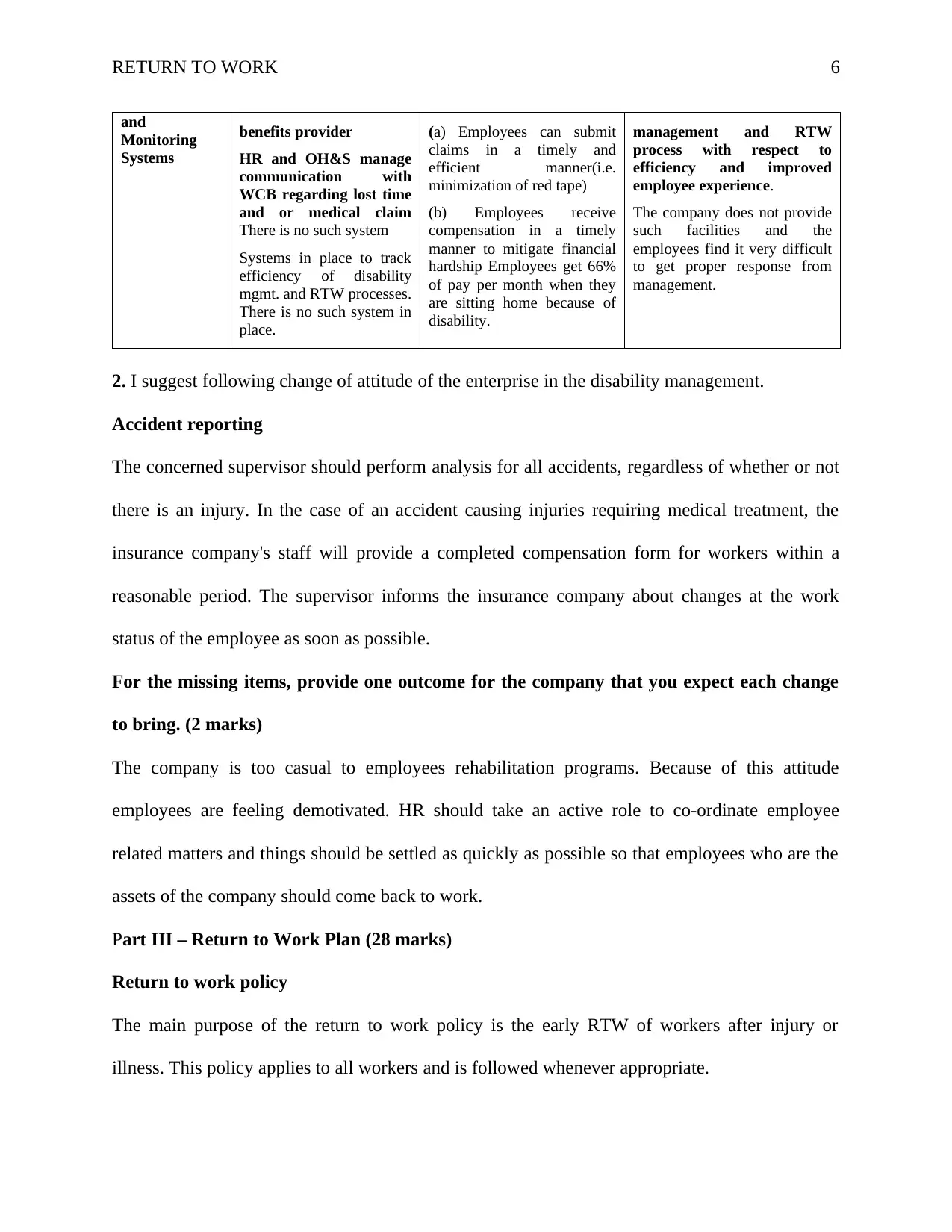
RETURN TO WORK 6
and
Monitoring
Systems
benefits provider
HR and OH&S manage
communication with
WCB regarding lost time
and or medical claim
There is no such system
Systems in place to track
efficiency of disability
mgmt. and RTW processes.
There is no such system in
place.
(a) Employees can submit
claims in a timely and
efficient manner(i.e.
minimization of red tape)
(b) Employees receive
compensation in a timely
manner to mitigate financial
hardship Employees get 66%
of pay per month when they
are sitting home because of
disability.
management and RTW
process with respect to
efficiency and improved
employee experience.
The company does not provide
such facilities and the
employees find it very difficult
to get proper response from
management.
2. I suggest following change of attitude of the enterprise in the disability management.
Accident reporting
The concerned supervisor should perform analysis for all accidents, regardless of whether or not
there is an injury. In the case of an accident causing injuries requiring medical treatment, the
insurance company's staff will provide a completed compensation form for workers within a
reasonable period. The supervisor informs the insurance company about changes at the work
status of the employee as soon as possible.
For the missing items, provide one outcome for the company that you expect each change
to bring. (2 marks)
The company is too casual to employees rehabilitation programs. Because of this attitude
employees are feeling demotivated. HR should take an active role to co-ordinate employee
related matters and things should be settled as quickly as possible so that employees who are the
assets of the company should come back to work.
Part III – Return to Work Plan (28 marks)
Return to work policy
The main purpose of the return to work policy is the early RTW of workers after injury or
illness. This policy applies to all workers and is followed whenever appropriate.
and
Monitoring
Systems
benefits provider
HR and OH&S manage
communication with
WCB regarding lost time
and or medical claim
There is no such system
Systems in place to track
efficiency of disability
mgmt. and RTW processes.
There is no such system in
place.
(a) Employees can submit
claims in a timely and
efficient manner(i.e.
minimization of red tape)
(b) Employees receive
compensation in a timely
manner to mitigate financial
hardship Employees get 66%
of pay per month when they
are sitting home because of
disability.
management and RTW
process with respect to
efficiency and improved
employee experience.
The company does not provide
such facilities and the
employees find it very difficult
to get proper response from
management.
2. I suggest following change of attitude of the enterprise in the disability management.
Accident reporting
The concerned supervisor should perform analysis for all accidents, regardless of whether or not
there is an injury. In the case of an accident causing injuries requiring medical treatment, the
insurance company's staff will provide a completed compensation form for workers within a
reasonable period. The supervisor informs the insurance company about changes at the work
status of the employee as soon as possible.
For the missing items, provide one outcome for the company that you expect each change
to bring. (2 marks)
The company is too casual to employees rehabilitation programs. Because of this attitude
employees are feeling demotivated. HR should take an active role to co-ordinate employee
related matters and things should be settled as quickly as possible so that employees who are the
assets of the company should come back to work.
Part III – Return to Work Plan (28 marks)
Return to work policy
The main purpose of the return to work policy is the early RTW of workers after injury or
illness. This policy applies to all workers and is followed whenever appropriate.
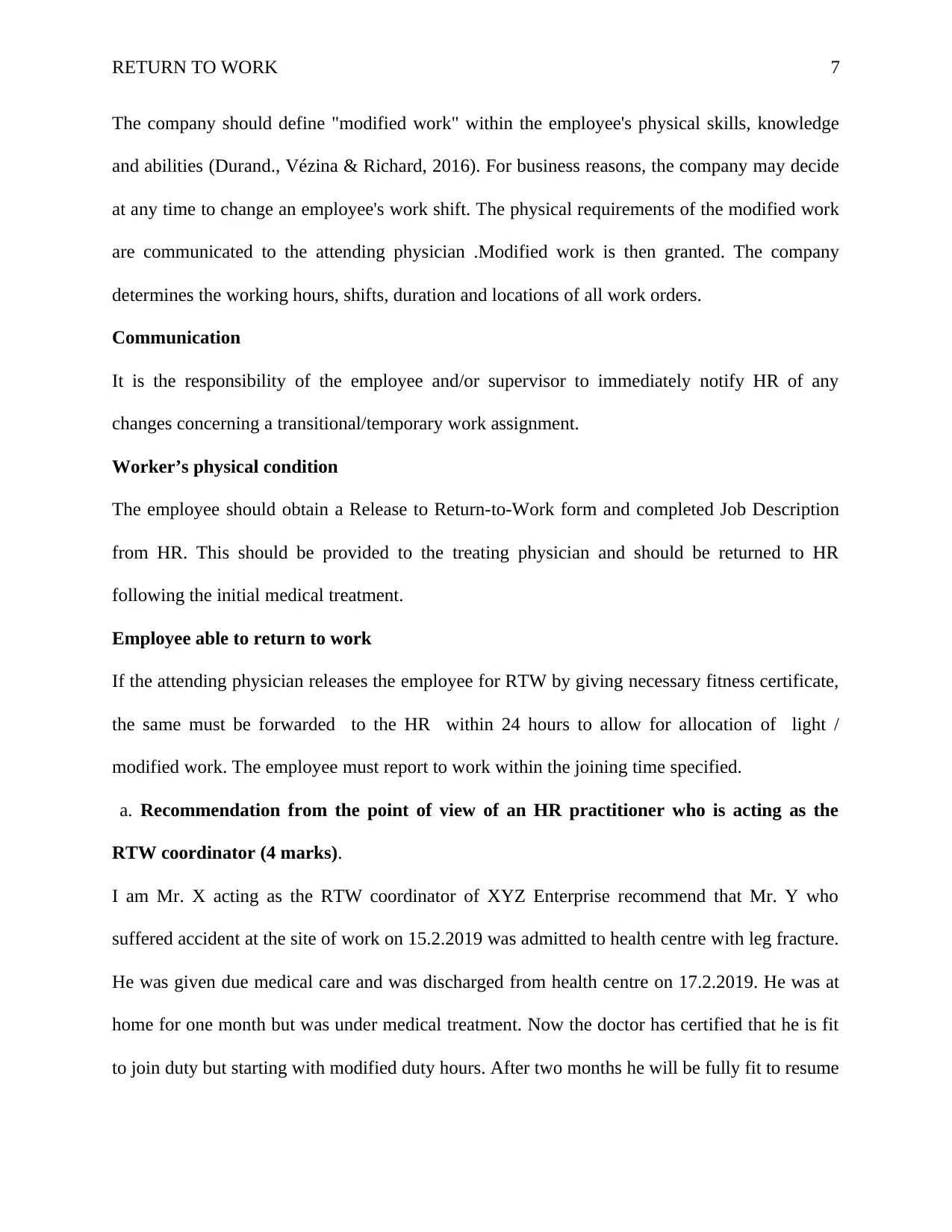
RETURN TO WORK 7
The company should define "modified work" within the employee's physical skills, knowledge
and abilities (Durand., Vézina & Richard, 2016). For business reasons, the company may decide
at any time to change an employee's work shift. The physical requirements of the modified work
are communicated to the attending physician .Modified work is then granted. The company
determines the working hours, shifts, duration and locations of all work orders.
Communication
It is the responsibility of the employee and/or supervisor to immediately notify HR of any
changes concerning a transitional/temporary work assignment.
Worker’s physical condition
The employee should obtain a Release to Return-to-Work form and completed Job Description
from HR. This should be provided to the treating physician and should be returned to HR
following the initial medical treatment.
Employee able to return to work
If the attending physician releases the employee for RTW by giving necessary fitness certificate,
the same must be forwarded to the HR within 24 hours to allow for allocation of light /
modified work. The employee must report to work within the joining time specified.
a. Recommendation from the point of view of an HR practitioner who is acting as the
RTW coordinator (4 marks).
I am Mr. X acting as the RTW coordinator of XYZ Enterprise recommend that Mr. Y who
suffered accident at the site of work on 15.2.2019 was admitted to health centre with leg fracture.
He was given due medical care and was discharged from health centre on 17.2.2019. He was at
home for one month but was under medical treatment. Now the doctor has certified that he is fit
to join duty but starting with modified duty hours. After two months he will be fully fit to resume
The company should define "modified work" within the employee's physical skills, knowledge
and abilities (Durand., Vézina & Richard, 2016). For business reasons, the company may decide
at any time to change an employee's work shift. The physical requirements of the modified work
are communicated to the attending physician .Modified work is then granted. The company
determines the working hours, shifts, duration and locations of all work orders.
Communication
It is the responsibility of the employee and/or supervisor to immediately notify HR of any
changes concerning a transitional/temporary work assignment.
Worker’s physical condition
The employee should obtain a Release to Return-to-Work form and completed Job Description
from HR. This should be provided to the treating physician and should be returned to HR
following the initial medical treatment.
Employee able to return to work
If the attending physician releases the employee for RTW by giving necessary fitness certificate,
the same must be forwarded to the HR within 24 hours to allow for allocation of light /
modified work. The employee must report to work within the joining time specified.
a. Recommendation from the point of view of an HR practitioner who is acting as the
RTW coordinator (4 marks).
I am Mr. X acting as the RTW coordinator of XYZ Enterprise recommend that Mr. Y who
suffered accident at the site of work on 15.2.2019 was admitted to health centre with leg fracture.
He was given due medical care and was discharged from health centre on 17.2.2019. He was at
home for one month but was under medical treatment. Now the doctor has certified that he is fit
to join duty but starting with modified duty hours. After two months he will be fully fit to resume
Paraphrase This Document
Need a fresh take? Get an instant paraphrase of this document with our AI Paraphraser

RETURN TO WORK 8
normal duty. For these two months, I recommend a light work at our company’s administrative
work limiting the duty hours to four hours per day.
b. Assess how the functional ability of the worker fits with the Physical Demand Analyses
(PDA) of the modified work position (4 marks)
The employee had injury in leg and he has got more than one and a half month for recuperation.
So he is fit enough to do duty for four hours a day at our administrative unit where the physical
labor required is very limited. Moreover the past record says he had earlier in the administrative
office for two years. So I am confident he will not find it difficult to manage the modified work
environment.
c. Determine the stakeholders and who outlines how the communication between them
should take place so that each stakeholder knows the whole situation and can act
accordingly. (10 marks)
Here the stakeholders who should work as a coordinated team include the supervisor, the doctor,
the RTW coordinator and the HR team. The supervisor should take care of immediate medical
facilities to be provided to the employee who has met with an accident. He also should take care
of his release from the hospital, The necessary paper work should be coordinated by him. The
doctor who is looking after him should give proper medical report and fitness certificate at the
time of the employee’s return to work (Denne, Kettner. & Ben-Shalom, 2015). The role of RTW
coordinator should design a new role for him when he is returning to modified work. The role of
HR has to settle his payments and also take fast decision on the employee’s return to work based
on the recommendation of RTW coordinator.
d. Identify barriers to RTW and how you will address them. (6 marks)
The barriers to return to work are the following issues.
normal duty. For these two months, I recommend a light work at our company’s administrative
work limiting the duty hours to four hours per day.
b. Assess how the functional ability of the worker fits with the Physical Demand Analyses
(PDA) of the modified work position (4 marks)
The employee had injury in leg and he has got more than one and a half month for recuperation.
So he is fit enough to do duty for four hours a day at our administrative unit where the physical
labor required is very limited. Moreover the past record says he had earlier in the administrative
office for two years. So I am confident he will not find it difficult to manage the modified work
environment.
c. Determine the stakeholders and who outlines how the communication between them
should take place so that each stakeholder knows the whole situation and can act
accordingly. (10 marks)
Here the stakeholders who should work as a coordinated team include the supervisor, the doctor,
the RTW coordinator and the HR team. The supervisor should take care of immediate medical
facilities to be provided to the employee who has met with an accident. He also should take care
of his release from the hospital, The necessary paper work should be coordinated by him. The
doctor who is looking after him should give proper medical report and fitness certificate at the
time of the employee’s return to work (Denne, Kettner. & Ben-Shalom, 2015). The role of RTW
coordinator should design a new role for him when he is returning to modified work. The role of
HR has to settle his payments and also take fast decision on the employee’s return to work based
on the recommendation of RTW coordinator.
d. Identify barriers to RTW and how you will address them. (6 marks)
The barriers to return to work are the following issues.
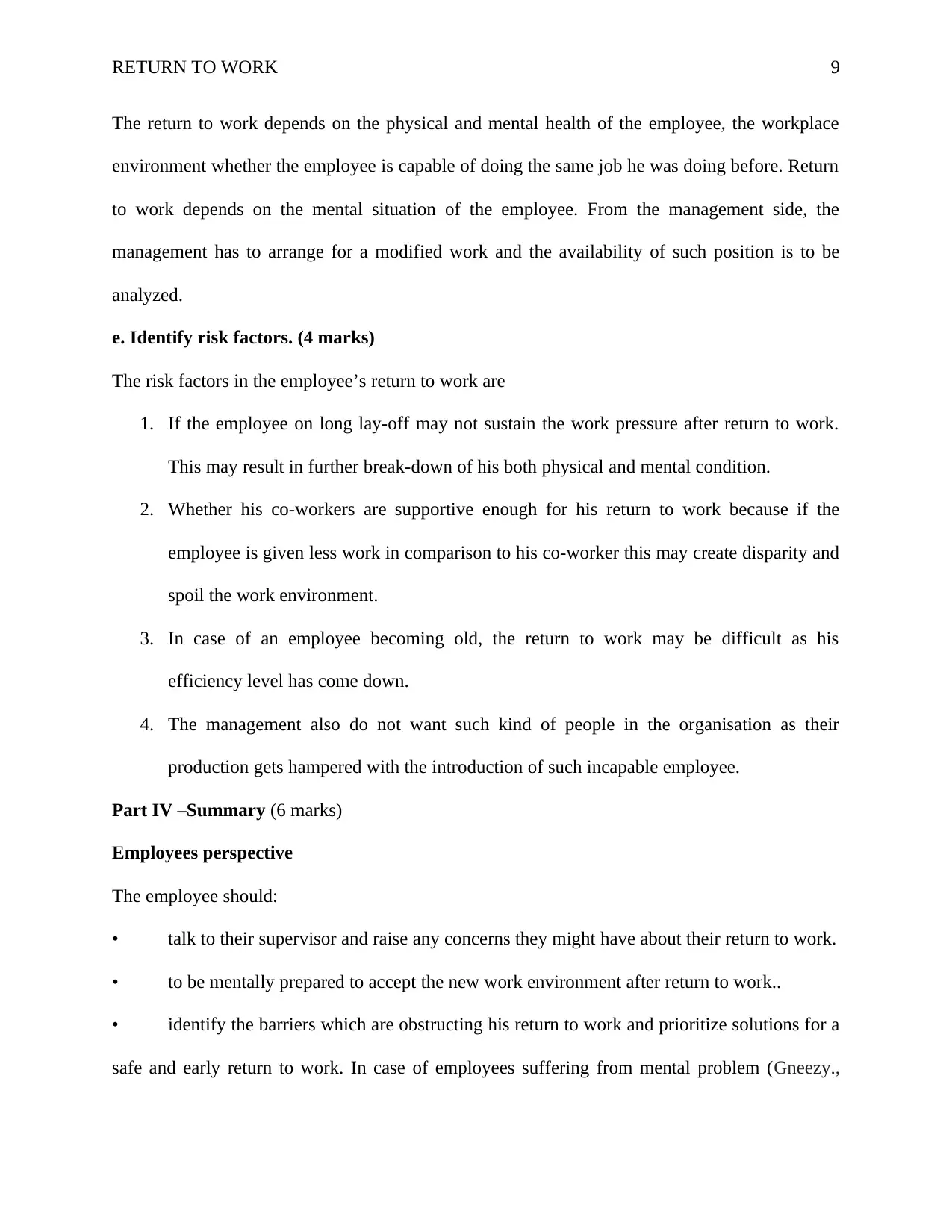
RETURN TO WORK 9
The return to work depends on the physical and mental health of the employee, the workplace
environment whether the employee is capable of doing the same job he was doing before. Return
to work depends on the mental situation of the employee. From the management side, the
management has to arrange for a modified work and the availability of such position is to be
analyzed.
e. Identify risk factors. (4 marks)
The risk factors in the employee’s return to work are
1. If the employee on long lay-off may not sustain the work pressure after return to work.
This may result in further break-down of his both physical and mental condition.
2. Whether his co-workers are supportive enough for his return to work because if the
employee is given less work in comparison to his co-worker this may create disparity and
spoil the work environment.
3. In case of an employee becoming old, the return to work may be difficult as his
efficiency level has come down.
4. The management also do not want such kind of people in the organisation as their
production gets hampered with the introduction of such incapable employee.
Part IV –Summary (6 marks)
Employees perspective
The employee should:
• talk to their supervisor and raise any concerns they might have about their return to work.
• to be mentally prepared to accept the new work environment after return to work..
• identify the barriers which are obstructing his return to work and prioritize solutions for a
safe and early return to work. In case of employees suffering from mental problem (Gneezy.,
The return to work depends on the physical and mental health of the employee, the workplace
environment whether the employee is capable of doing the same job he was doing before. Return
to work depends on the mental situation of the employee. From the management side, the
management has to arrange for a modified work and the availability of such position is to be
analyzed.
e. Identify risk factors. (4 marks)
The risk factors in the employee’s return to work are
1. If the employee on long lay-off may not sustain the work pressure after return to work.
This may result in further break-down of his both physical and mental condition.
2. Whether his co-workers are supportive enough for his return to work because if the
employee is given less work in comparison to his co-worker this may create disparity and
spoil the work environment.
3. In case of an employee becoming old, the return to work may be difficult as his
efficiency level has come down.
4. The management also do not want such kind of people in the organisation as their
production gets hampered with the introduction of such incapable employee.
Part IV –Summary (6 marks)
Employees perspective
The employee should:
• talk to their supervisor and raise any concerns they might have about their return to work.
• to be mentally prepared to accept the new work environment after return to work..
• identify the barriers which are obstructing his return to work and prioritize solutions for a
safe and early return to work. In case of employees suffering from mental problem (Gneezy.,
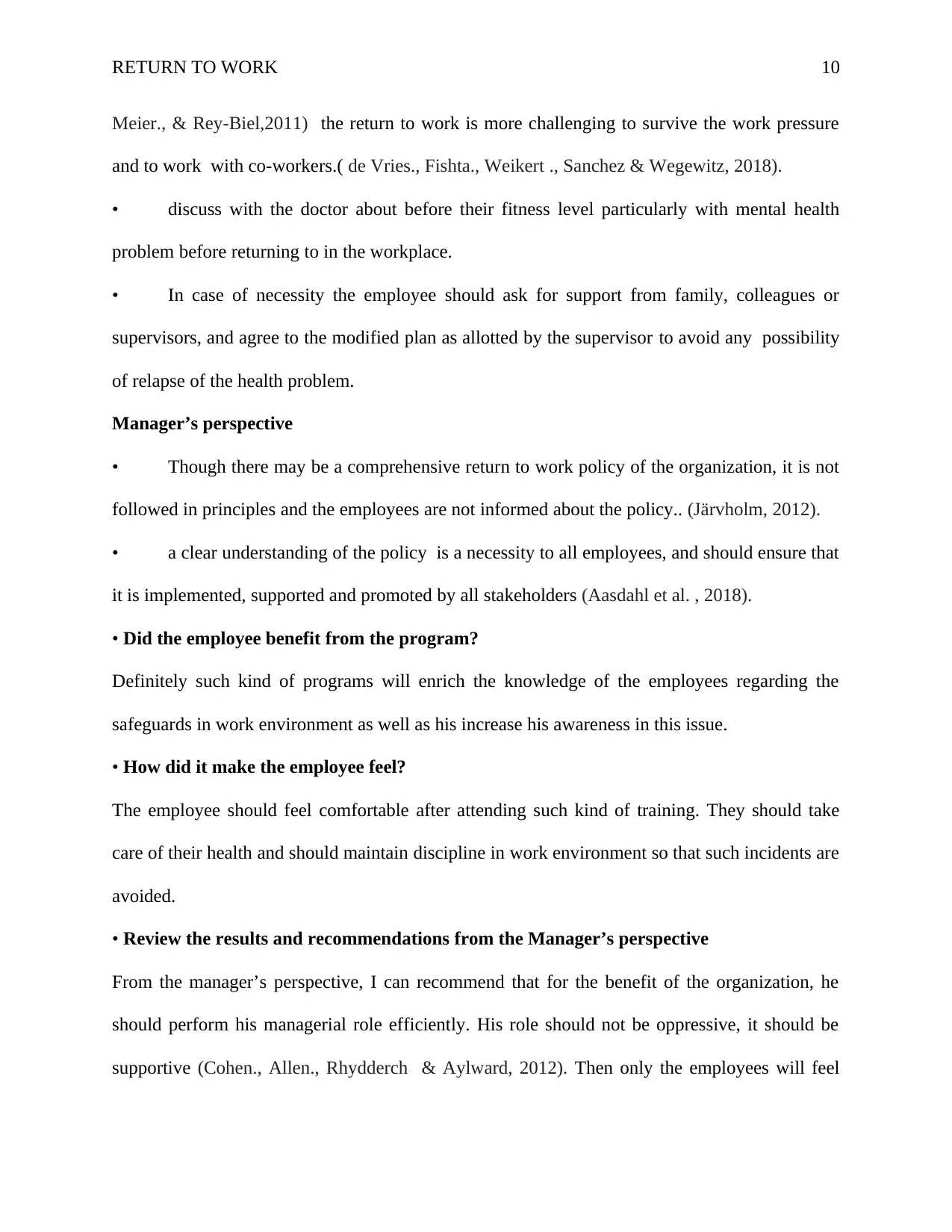
RETURN TO WORK 10
Meier., & Rey-Biel,2011) the return to work is more challenging to survive the work pressure
and to work with co-workers.( de Vries., Fishta., Weikert ., Sanchez & Wegewitz, 2018).
• discuss with the doctor about before their fitness level particularly with mental health
problem before returning to in the workplace.
• In case of necessity the employee should ask for support from family, colleagues or
supervisors, and agree to the modified plan as allotted by the supervisor to avoid any possibility
of relapse of the health problem.
Manager’s perspective
• Though there may be a comprehensive return to work policy of the organization, it is not
followed in principles and the employees are not informed about the policy.. (Järvholm, 2012).
• a clear understanding of the policy is a necessity to all employees, and should ensure that
it is implemented, supported and promoted by all stakeholders (Aasdahl et al. , 2018).
• Did the employee benefit from the program?
Definitely such kind of programs will enrich the knowledge of the employees regarding the
safeguards in work environment as well as his increase his awareness in this issue.
• How did it make the employee feel?
The employee should feel comfortable after attending such kind of training. They should take
care of their health and should maintain discipline in work environment so that such incidents are
avoided.
• Review the results and recommendations from the Manager’s perspective
From the manager’s perspective, I can recommend that for the benefit of the organization, he
should perform his managerial role efficiently. His role should not be oppressive, it should be
supportive (Cohen., Allen., Rhydderch & Aylward, 2012). Then only the employees will feel
Meier., & Rey-Biel,2011) the return to work is more challenging to survive the work pressure
and to work with co-workers.( de Vries., Fishta., Weikert ., Sanchez & Wegewitz, 2018).
• discuss with the doctor about before their fitness level particularly with mental health
problem before returning to in the workplace.
• In case of necessity the employee should ask for support from family, colleagues or
supervisors, and agree to the modified plan as allotted by the supervisor to avoid any possibility
of relapse of the health problem.
Manager’s perspective
• Though there may be a comprehensive return to work policy of the organization, it is not
followed in principles and the employees are not informed about the policy.. (Järvholm, 2012).
• a clear understanding of the policy is a necessity to all employees, and should ensure that
it is implemented, supported and promoted by all stakeholders (Aasdahl et al. , 2018).
• Did the employee benefit from the program?
Definitely such kind of programs will enrich the knowledge of the employees regarding the
safeguards in work environment as well as his increase his awareness in this issue.
• How did it make the employee feel?
The employee should feel comfortable after attending such kind of training. They should take
care of their health and should maintain discipline in work environment so that such incidents are
avoided.
• Review the results and recommendations from the Manager’s perspective
From the manager’s perspective, I can recommend that for the benefit of the organization, he
should perform his managerial role efficiently. His role should not be oppressive, it should be
supportive (Cohen., Allen., Rhydderch & Aylward, 2012). Then only the employees will feel
Secure Best Marks with AI Grader
Need help grading? Try our AI Grader for instant feedback on your assignments.
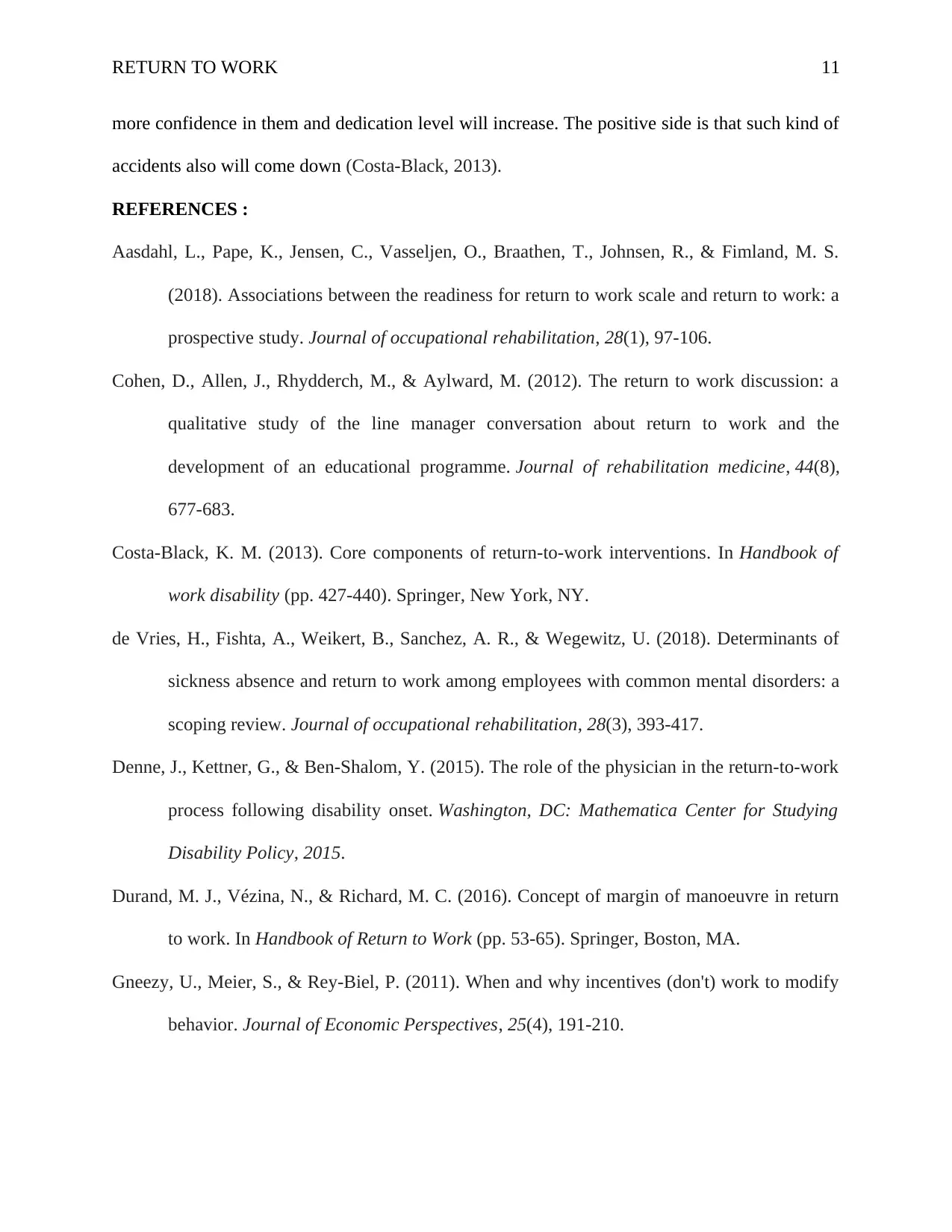
RETURN TO WORK 11
more confidence in them and dedication level will increase. The positive side is that such kind of
accidents also will come down (Costa-Black, 2013).
REFERENCES :
Aasdahl, L., Pape, K., Jensen, C., Vasseljen, O., Braathen, T., Johnsen, R., & Fimland, M. S.
(2018). Associations between the readiness for return to work scale and return to work: a
prospective study. Journal of occupational rehabilitation, 28(1), 97-106.
Cohen, D., Allen, J., Rhydderch, M., & Aylward, M. (2012). The return to work discussion: a
qualitative study of the line manager conversation about return to work and the
development of an educational programme. Journal of rehabilitation medicine, 44(8),
677-683.
Costa-Black, K. M. (2013). Core components of return-to-work interventions. In Handbook of
work disability (pp. 427-440). Springer, New York, NY.
de Vries, H., Fishta, A., Weikert, B., Sanchez, A. R., & Wegewitz, U. (2018). Determinants of
sickness absence and return to work among employees with common mental disorders: a
scoping review. Journal of occupational rehabilitation, 28(3), 393-417.
Denne, J., Kettner, G., & Ben-Shalom, Y. (2015). The role of the physician in the return-to-work
process following disability onset. Washington, DC: Mathematica Center for Studying
Disability Policy, 2015.
Durand, M. J., Vézina, N., & Richard, M. C. (2016). Concept of margin of manoeuvre in return
to work. In Handbook of Return to Work (pp. 53-65). Springer, Boston, MA.
Gneezy, U., Meier, S., & Rey-Biel, P. (2011). When and why incentives (don't) work to modify
behavior. Journal of Economic Perspectives, 25(4), 191-210.
more confidence in them and dedication level will increase. The positive side is that such kind of
accidents also will come down (Costa-Black, 2013).
REFERENCES :
Aasdahl, L., Pape, K., Jensen, C., Vasseljen, O., Braathen, T., Johnsen, R., & Fimland, M. S.
(2018). Associations between the readiness for return to work scale and return to work: a
prospective study. Journal of occupational rehabilitation, 28(1), 97-106.
Cohen, D., Allen, J., Rhydderch, M., & Aylward, M. (2012). The return to work discussion: a
qualitative study of the line manager conversation about return to work and the
development of an educational programme. Journal of rehabilitation medicine, 44(8),
677-683.
Costa-Black, K. M. (2013). Core components of return-to-work interventions. In Handbook of
work disability (pp. 427-440). Springer, New York, NY.
de Vries, H., Fishta, A., Weikert, B., Sanchez, A. R., & Wegewitz, U. (2018). Determinants of
sickness absence and return to work among employees with common mental disorders: a
scoping review. Journal of occupational rehabilitation, 28(3), 393-417.
Denne, J., Kettner, G., & Ben-Shalom, Y. (2015). The role of the physician in the return-to-work
process following disability onset. Washington, DC: Mathematica Center for Studying
Disability Policy, 2015.
Durand, M. J., Vézina, N., & Richard, M. C. (2016). Concept of margin of manoeuvre in return
to work. In Handbook of Return to Work (pp. 53-65). Springer, Boston, MA.
Gneezy, U., Meier, S., & Rey-Biel, P. (2011). When and why incentives (don't) work to modify
behavior. Journal of Economic Perspectives, 25(4), 191-210.

RETURN TO WORK 12
Hou, W. H., Liang, H. W., Sheu, C. F., Hsieh, C. L., & Chuang, H. Y. (2013). Return to work
and quality of life in workers with traumatic limb injuries: a 2-year repeated-
measurements study. Archives of physical medicine and rehabilitation, 94(4), 703-710.
Järvholm, B. (2012). How should methods for return to work be evaluated?. Scandinavian
journal of work, environment & health, 89-91.
Saunders, S. L., & Nedelec, B. (2014). What work means to people with work disability: a
scoping review. Journal of occupational rehabilitation, 24(1), 100-110.
Hou, W. H., Liang, H. W., Sheu, C. F., Hsieh, C. L., & Chuang, H. Y. (2013). Return to work
and quality of life in workers with traumatic limb injuries: a 2-year repeated-
measurements study. Archives of physical medicine and rehabilitation, 94(4), 703-710.
Järvholm, B. (2012). How should methods for return to work be evaluated?. Scandinavian
journal of work, environment & health, 89-91.
Saunders, S. L., & Nedelec, B. (2014). What work means to people with work disability: a
scoping review. Journal of occupational rehabilitation, 24(1), 100-110.
1 out of 12
Your All-in-One AI-Powered Toolkit for Academic Success.
+13062052269
info@desklib.com
Available 24*7 on WhatsApp / Email
![[object Object]](/_next/static/media/star-bottom.7253800d.svg)
Unlock your academic potential
© 2024 | Zucol Services PVT LTD | All rights reserved.

